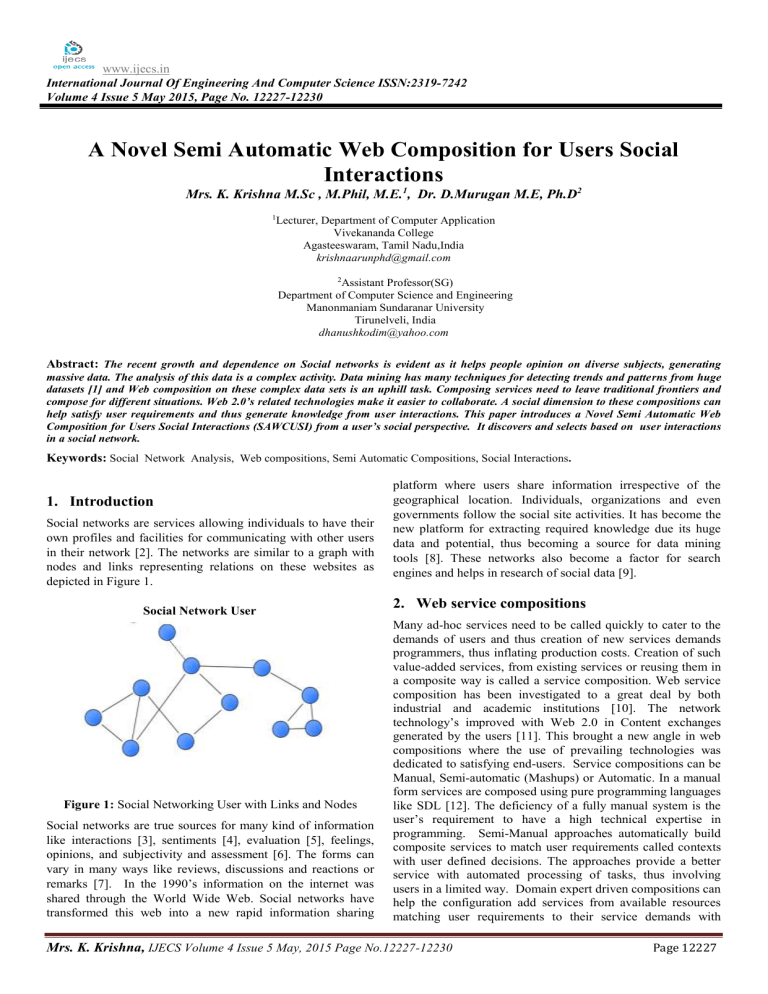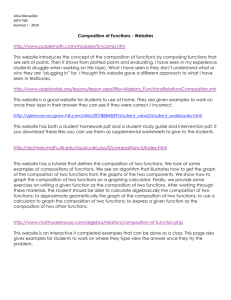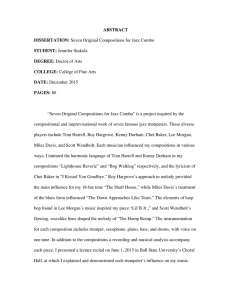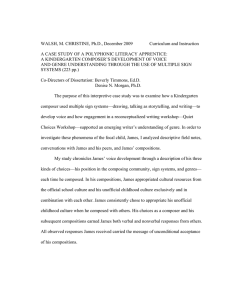www.ijecs.in International Journal Of Engineering And Computer Science ISSN:2319-7242

www.ijecs.in
International Journal Of Engineering And Computer Science ISSN:2319-7242
Volume 4 Issue 5 May 2015, Page No. 12227-12230
A Novel Semi Automatic Web Composition for Users Social
Interactions
Mrs. K. Krishna M.Sc , M.Phil, M.E.
1
, Dr. D.Murugan M.E, Ph.D
2
1 Lecturer, Department of Computer Application
Vivekananda College
Agasteeswaram, Tamil Nadu,India krishnaarunphd@gmail.com
2 Assistant Professor(SG)
Department of Computer Science and Engineering
Manonmaniam Sundaranar University
Tirunelveli, India dhanushkodim@yahoo.com
Abstract: The recent growth and dependence on Social networks is evident as it helps people opinion on diverse subjects, generating massive data. The analysis of this data is a complex activity. Data mining has many techniques for detecting trends and patterns from huge datasets [1] and Web composition on these complex data sets is an uphill task. Composing services need to leave traditional frontiers and compose for different situations. Web 2.0’s related technologies make it easier to collaborate. A social dimension to these compositions can help satisfy user requirements and thus generate knowledge from user interactions. This paper introduces a Novel Semi Automatic Web
Composition for Users Social Interactions (SAWCUSI) from a user’s social perspective. It discovers and selects based on user interactions in a social network.
Keywords: Social Network Analysis, Web compositions, Semi Automatic Compositions, Social Interactions .
1.
Introduction
platform where users share information irrespective of the geographical location. Individuals, organizations and even
Social networks are services allowing individuals to have their own profiles and facilities for communicating with other users governments follow the social site activities. It has become the new platform for extracting required knowledge due its huge in their network [2]. The networks are similar to a graph with nodes and links representing relations on these websites as data and potential, thus becoming a source for data mining tools [8]. These networks also become a factor for search engines and helps in research of social data [9]. depicted in Figure 1.
Social Network User
Figure 1: Social Networking User with Links and Nodes
Social networks are true sources for many kind of information like interactions [3], sentiments [4], evaluation [5], feelings, opinions, and subjectivity and assessment [6]. The forms can vary in many ways like reviews, discussions and reactions or remarks [7]. In the 1990’s information on the internet was shared through the World Wide Web. Social networks have transformed this web into a new rapid information sharing
2.
Web service compositions
Many ad-hoc services need to be called quickly to cater to the demands of users and thus creation of new services demands programmers, thus inflating production costs. Creation of such value-added services, from existing services or reusing them in a composite way is called a service composition. Web service composition has been investigated to a great deal by both industrial and academic institutions [10]. The network technology’s improved with Web 2.0 in Content exchanges generated by the users [11]. This brought a new angle in web compositions where the use of prevailing technologies was dedicated to satisfying end-users. Service compositions can be
Manual, Semi-automatic (Mashups) or Automatic. In a manual form services are composed using pure programming languages like SDL [12]. The deficiency of a fully manual system is the user’s requirement to have a high technical expertise in programming. Semi-Manual approaches automatically build composite services to match user requirements called contexts with user defined decisions. The approaches provide a better service with automated processing of tasks, thus involving users in a limited way. Domain expert driven compositions can help the configuration add services from available resources matching user requirements to their service demands with
Mrs. K. Krishna,
IJECS Volume 4 Issue 5 May, 2015 Page No.12227-12230
Page 12227
minimum overheads. A user knows exactly the required services for his links or his community. Though previous researches have analyzed social networks from several view points, there is an impending need to exploit social networks in web compositions, thus making it imperative to research in this direction. ASemi-automatic web service composition called
WCUS is proposed focusing on the social interactions in a social network.
3.
Semi-Automatic Compositions
Semi-automatic service compositions have evolved over the years, catering to single users or a community. In a Single user composition, the composition builds a profile with his involvement in stages which require a decision. Tools and interfaces to facilitate this kind of web composition are mashups, BPEL-tools etc. The community compositions target the knowledge produced by communities. The extraction is defined by a set of rules and recommendations in the composition, where Chen et. Al’s introduction to services compositions was remarkable [13]. Semantic processing enables a complicated service discovery [14, 15]. Web compositions of Social Networks are semi-automatic in nature.
It describes specific structures based on a common area of interest thus generating communities in those areas. Web 2.0 web interactions and collaborations emphasize social interactions and presents opportunities for social networks like
Facebook or Twitter which are interesting sources of knowledge for web compositions. Collaboration involves creating compositions to perform specific tasks.
4.
Web Composition for Users Social
Interactions (SAWCUSI)
Any social network composition should cater to an interaction between a user and services requested by him. The SAWCUSI composition offers a complete solution to user’s requests.
When a user requests for a service, it is looked up in the frameworks services list. The first time a user requests a service the framework looks up the services library of the framework and updates it services list, while servicing the user’s service request. The service list thus starts having the names of available services from the services library. When a user requests a service which is not available in the composition,
SAWCUSI, connects to other social network compositions and searches for the service’s availability. On receiving a positive response, it again updates its services list on the service availability and services the request on receiving the service from the other framework. If not found in other connected compositions then it pushes the details into an error log. The error log is looked up periodically to check services that are unavailable in the frameworks list and gets transformed into a creation for a new service. The error log is checked manually and the decision of creating a new service with the help of a domain expert is taken. On the creation of a new service the service library is updated, thus catering to requests for new services from the users. The framework can also be used to extract useful knowledge on these social interactions. The
SAWCUSI architecture is depicted in Figure. 2.
SAWCUSI Web
Composition
Existing
User
Services
Service s
Library
Search , Web,
Shop, Travel,
Bookings
User
Service
Request
SAWCUSI
Services List
Creation
Experts
Unavailabl e
Services
Error Log
New Service with Domain
Search
Other
Repositori es
Mining
Social
Knowledg e
Figure 2: SAWCUSI Architecture for Social Interaction
Integration
The main idea of SAWCUSI is to capitalize on information and knowledge from social media data either implicitly or explicitly. Explicit is by requesting a user to participate or share in a survey and informing on the decided intent. In an implicit operation, a social relation can be inferred based on the activities of users. When user requests a service used by another user, it does get linked with the same area of interests.
The user’s interaction history contains information on his service utilizations in the composition, thus helping learn about that particular area of service utilization. A social networking user’s profile contains information about his preferences and the links can be used to calculate social proximity with others in a context. When one user in a link uses a service, it is automatically followed by most in the link, even if out of curiosity. It thus becomes important to extract and analyze
Mrs. K. Krishna,
IJECS Volume 4 Issue 5 May, 2015 Page No.12227-12230
Page 12228
these kinds of information in a social network. The outputs of the analysis would typically have information on a user’s social proximities and service interactions. The Social proximity of a user can be calculated on the count of the interactions between users. The output can also propose a list of regularly used services and rank them based on the analysis. A ranked service is thus proportional to the social proximity of user implying most used service is ranked higher and for a new user who joins the fraternity, the ranked services list can offered. When a user ranks a service, the user assumes the role of an expert in the service, due the regular participation and exploitation. It can be mathematically depicted in Equation (1)
{Ui : i = 1
…
.n} = f( Sj : j = 1
…
.m) (1)
Where U i
represents users in social network and S j
represents the services. And f(S j
) representing the analysis function which chooses the services and ranks it. The recommendation for the web composition skeleton structure having the frequently used services can be obtained using Equation (2) n m
RS(S n
) =
∑
(S j
) x E(S j
) i=1
(2)
Where RS is the Ranked Service from the list of services S j and m is the count of its usage by users and E the expertise of users in using the service. The Algorithm for selection of ranked services is listed below
Algorithm for selection of ranked services for SAWCUSI
Inputs : {U i
: i=1….n} and ( S j
: n=1….m) for each U i
where i=1..n do
RS = 0 for each S j
where j=1..m do
if S j
= Preferred by U i
and existing and running then
RS = RS + (S j
) x E(S j
)
End if
Next j end for
Add (S j
,RS) in Rank List end for
Sort Rank LiList = f(S j
;RS)
Rank
5.
Conclusion and Future Work
The paper has discussed the need for considering social interactions in Web service compositions for social networks and its role in improving it. The paper has underlined the importance of semi-automatic composition and also the need to involve humans at different levels of web composition processes. Underlying Web 2.0 makes it easier to do collaborative work required for web compositions from user generated contents and social networks. The paper also suggests considering existing compositions while creating or configuring new web compositions. The paper also emphasizes the importance of a user’s preferences in services and ranks and recommends them. The more the framework is in use, the more its gets updated on new services and also services that are found in other compositions to provide scalability and save time. Only when a service is not found in any other composition in the network is it recommended for creation with programmers. The composition can also be termed dynamic, due to the framework’s capability to get updated on new services from other compositions. The framework becomes a major source for analysis and mining data from user’s stored information, thus making it recommendable for usage in social networks. Thus the paper has demonstrated the use of the
SAWCUSI framework and ahs also contributed with a model algorithm for selection of most used services.
References
[1] Kagdi, H., Collard, M. L., Maletic, J. I.: A survey and taxonomy of approaches for mining software repositories in the context of software evolution. J. Softw. Maint.
Evol.: Res. Pract, 19, 77-131, 2007
[2] Chen, Z. S., Kalashnikov, D. V. and Mehrotra, S.
Exploiting context analysis for combining multiple entity resolution systems. In Proceedings of the 2009 ACM
International Conference on Management of Data
(SIGMOD'09), 2009
[3] Thompson, J B.: Media and modernity: A social theory of the media. John Wiley & Sons, 2013
[4] Pang, B. and Lee, L.: Opinion mining and sentiment analysis; Foundations and trends in information Retrieval;
Vol. 2, Nos. 1–2, 1–135, 2008
[5] Kaur, G.: Social network evaluation criteria and influence on consumption behaviour of the youth segment. 2013
[6] Kim, Y., Hsu, S-H., de Zuniga, H.G.: Influence of social network use on discussion network heterogeneity and civic engagement: The moderating role of personality traits. Journal of Communication 63.3, 498-516, 2013
[7] Liu, B.: Sentiment analysis and opinion Mining. AAAI-
2011, San Francisco, USA, 2011
[8] Cortizo, J., Carrero, F., Gomez, J., Monsalve, B., Puertas,
E.: Introduction to Mining SM. In: Proceedings of the 1st
International Workshop on Mining SM, 1 – 3, 2009
[9] Aggarwal, C.: An introduction to social network data analytics. Springer US, 2011.
[10] M. H. ter Beek, A. Bucchiarone, and S. Gnesi, “Web service composition approaches: From industrial standards to formal methods,” in ICIW, 2007, pp. 15–20
[11] Kaplan, A.M. and Haenlein, M.: Users of the world unite!
The challenges and opportunities of social media. Science direct, 53, 59-68, 2010
[12] M. Broy, “Towards a formal foundation of the specification and descrip-tion language sdl,” Formal
Aspects of Computing, vol. 3, pp. 21–57, 1991
[13] L. Chen, N. Shadbolt, C. Goble, F. Tao, S. Cox, C.
Puleston, and P. Smart, “Towards a knowledge-based approach to semantic service composition,” Lecture Notes in Computer Science, pp. 319–334, 2003
[14] E. Sirin, J. Hendler, and B. Parsia, “Semi-automatic composition of web services using semantic descriptions,” in Web Services: Modeling, Ar-chitecture and
Infrastructure” workshop in conjunction with ICEIS2003,
2002.
[15] M. Paolucci, T. Kawamura, T. R. Payne, and K. P.
Sycara, “Semantic matching of web services capabilities,” in ISWC ’02. London, UK: Springer-Verlag, 2002, pp.
333–347
Author Profile
Mrs. K. Krishna,
IJECS Volume 4 Issue 5 May, 2015 Page No.12227-12230
Page 12229
K.Krishna received her B.Sc in Computer Science from Madurai
Kamaraj University in 1992 and M.Sc in Computer Science from
Avinashilingam Deemed University in 1994 and M.E in Computer
Science from Vinayaka Misson University in 2007respectively.Sheis a Lecturer in Department of Computer Application.
Mrs. K. Krishna,
IJECS Volume 4 Issue 5 May, 2015 Page No.12227-12230
Page 12230






